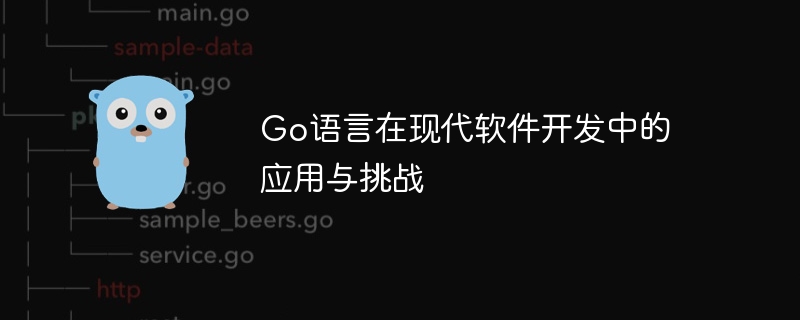Home >Backend Development >Golang >The application and problems of Go language in contemporary software development
The application and problems of Go language in contemporary software development
- PHPzOriginal
- 2024-01-23 08:52:151133browse

The application and challenges of Go language in modern software development
Introduction:
With the rapid development of the Internet, modern software development is facing more and more challenges challenges. In this increasingly competitive market, developers need to use efficient and reliable tools and languages to improve development efficiency and application performance. As a modern programming language, Go language has emerged in the field of software development and has become the first choice of many developers.
1. Advantages of Go language
Go language has many unique characteristics, which make it widely used in modern software development.
- Concurrency performance
The Go language has built-in powerful concurrency processing capabilities. Through the goroutine and channel mechanisms, concurrent programming can be easily performed. This allows developers to easily implement efficient concurrent operations, take full advantage of multi-core processors, and improve application performance.
The following is a simple sample code that shows how to use goroutine to handle multiple tasks at the same time:
package main
import (
"fmt"
"time"
)
func task(name string) {
for i := 1; i <= 5; i++ {
time.Sleep(time.Second)
fmt.Printf("%s: %d
", name, i)
}
}
func main() {
go task("task1")
go task("task2")
// 主goroutine等待其他goroutine执行完毕
time.Sleep(6 * time.Second)
}In the above code, we created two goroutines and executed them respectivelytask1 and task2 functions, each function will wait for 1 second to print once. Parallel execution can be achieved by using goroutine, which greatly shortens the execution time.
- Memory Management
The Go language uses a garbage collection mechanism, so developers do not need to manually manage memory, reducing problems caused by memory leaks. At the same time, the garbage collection mechanism of the Go language is also very efficient and will not have a significant impact on application performance.
The following is a sample code using Go language for memory management:
package main
import (
"fmt"
"runtime"
)
func main() {
// 查看初始内存使用情况
var m runtime.MemStats
runtime.ReadMemStats(&m)
fmt.Printf("Initial Memory Usage: %d KB
", m.Alloc/1024)
// 分配一个大数组
const SIZE = 1024 * 1024 * 10
array := make([]int, SIZE)
// 查看内存使用情况
runtime.ReadMemStats(&m)
fmt.Printf("Memory Usage after Allocation: %d KB
", m.Alloc/1024)
// 释放数组
array = nil
runtime.GC()
// 再次查看内存使用情况
runtime.ReadMemStats(&m)
fmt.Printf("Memory Usage after Deallocation: %d KB
", m.Alloc/1024)
}In the above code, we first check the initial memory usage of the program, and then allocate a large array , checked the memory usage again, and finally freed the array and checked the final memory usage. By using related functions in the runtime package, we can easily obtain and monitor memory usage.
- Easy-to-use standard library
The Go language has a rich and easy-to-use standard library, covering many common areas such as networking, file processing, and regular expressions. By using the standard library, developers can save a lot of time and energy and quickly build high-quality applications.
The following is a sample code, using the standard library of Go language for network programming:
package main
import (
"fmt"
"net/http"
)
func handler(w http.ResponseWriter, r *http.Request) {
fmt.Fprintf(w, "Hello, Go Language!")
}
func main() {
http.HandleFunc("/", handler)
http.ListenAndServe(":8080", nil)
}In the above code, we wrote a simple HTTP server. When accessing the root path , the server will return "Hello, Go Language!". By using the related functions and types in the http package, we can quickly build a server-side application based on the HTTP protocol.
2. Challenges faced by Go language
Although Go language has many advantages in modern software development, it also faces some challenges and limitations.
- The ecosystem is not perfect enough
Compared with some mature programming languages and frameworks, the Go language ecosystem is not perfect enough. Although the Go language has a rich standard library, you may encounter some missing or imperfect functions during the development process. At this time, developers need to write their own or rely on third-party libraries to complete the corresponding functions. - Lack of generic support
The Go language does not currently support generics, which may cause some limitations in the implementation of some complex data structures and algorithms. Developers need to use some special techniques and patterns to overcome this limitation. - Performance optimization requires careful thinking
Although the Go language performs well in terms of concurrency performance and memory management, it may not be as outstanding as some other underlying languages in other aspects. In order to improve application performance, developers need to carefully analyze application bottlenecks and take corresponding optimization measures.
Conclusion:
As a modern programming language, Go language has been widely used in modern software development. Its concurrency performance, memory management, and easy-to-use standard library make it the first choice for developers. Despite facing some challenges and limitations, with developers' in-depth understanding of the Go language and the development of the ecosystem, I believe that the Go language will achieve greater success in the future.
The above is the detailed content of The application and problems of Go language in contemporary software development. For more information, please follow other related articles on the PHP Chinese website!
Related articles
See more- How to set go language environment variables
- How to upgrade the go language version
- What does application data mean? Can it be deleted?
- What are the differences between go language and java?
- An exclusive interview with Professor Ou Zhijian from Tsinghua University, providing an in-depth analysis of ChatGPT's aura and future challenges!

